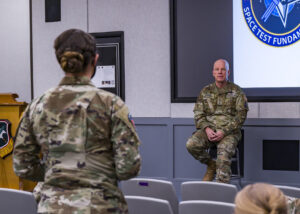This is important to make sure the Space Force can defend satellites from high-tech weapons such as electronic jammers and lasers, Gen. John Raymond, chief of space operations of the U.S. Space Force, told reporters May 6.
“Being a digital service will help us address many of these threats as they materialize,” Raymond said.
A high-tech force also is needed to innovate weapons systems and business processes, he said. Given the relatively small size of the Space Force, people have to be “digitally fluent, efficient, and agile,” said Raymond.
The Space Force was established in December 2019 as an independent military branch and expects to have about 16,000 members, half military and half civilian. By comparison, the Marine Corps has about 180,000 personnel.
Raymond said the goal is to keep the force small but ensure it’s highly skilled. Service members attend the Department of the Air Force’s Digital University, a virtual school that offers courses such as digital product development, introduction to information technology infrastructure, data science and artificial intelligence and cybersecurity.
The Space Force also wants its members to learn programming languages, machine learning and data analysis. It created coding boot camps where operators learn to write software for applications in space traffic control, satellite operations and space data analysis.
Maj. Gen. Kimberly Crider, the Space Force chief technology and innovation officer, said the plan is to transition to a fully digital design and engineering ecosystem for acquisition programs.
The Space Force needs to be able to solve “big data problems” such as tracking thousands of satellites and pieces of debris in orbit, said Crider. “We need to capture and analyze as much data as possible to understand the domain.”



